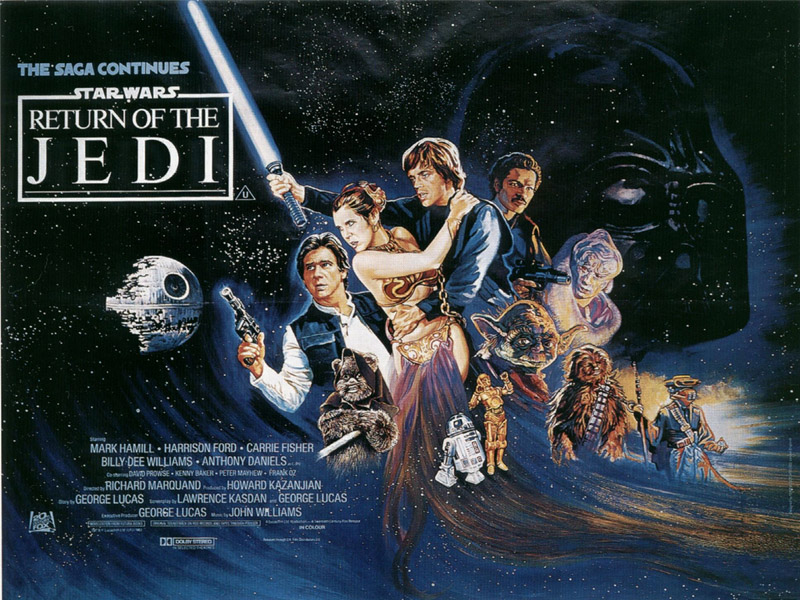The price of gold has fallen over $200 in the last two days. This sounds like 1983 all over again.
Not only did Star Wars Episode VI come out in 1983, but gold experienced its largest one-day fall in recorded market history. On February 28, 1983 the metal fell $56, a whopping 11.5%. The context in which this collapse happened is worth revisiting since it might help explain some of what we are seeing now. I'll take a short diversion through 1983 oil markets before getting back to gold.
There were plenty of worries of an oil glut leading up to the metal's 1983 collapse. OPEC, which had kept an iron grip on oil prices by adjusting production, had been steadily losing its dominant position as oil producer. In the 1970s the cartel controlled over 60% of world production. Small adjustments to the rate at which it extracted crude were sufficient to set a floor in the oil market. But increased supply in the UK, Norway, USSR, and Mexico had eroded this share to under 40% by the early 1980s. As a result, OPEC nations were required to remove ever larger amounts of oil from the market to support prices.
The coordination necessary to motivate these adjustments was lacking. Beginning in June 1982, OPEC tried and failed three times within seven months to set quotas. As a result, spot prices had begun to trade well below OPEC's benchmark Saudi light price of $34, a gap that started to expand quite dramatically in winter and early 1983, as the chart below shows.
Because of the glut, the cartel was breaking at the seams. On February 17, 1983, the British National Oil Company (a government marketing board that bought 51% of North Sea output) dropped its North Sea price by $3 to $30.50, quickly followed by Norway. Nigeria, an OPEC member, reacted on February 19 by ignoring OPEC and reducing the price of Bonny light, a crude stream similar to Brent, from $35 to $30.
A week later the gold price collapsed. And on March 14, 1983, OPEC announced the first ever decrease in its benchmark price, with Saudi light now being priced at $29, down $5 from $34. We know what happened next. The glut continued and oil prices steadily declined until all-out collapse to $12 in early 1986 when Saudi Arabia, tired of OPEC squabbling, decided to open the taps and let all their partners suffer.
Zoom forward thirty years and we also have an oil glut:
The tight-oil revolution, the realization that the drill bit can liberate oil from reservoirs once-considered insufficiently porous to yield sufficient oil flows, is coursing through North America and will inevitably spread to the rest of the world. There's so much oil collecting in the US that the price at Cushing, Oklahoma trades 10% below European Brent.
What are we to make of these twin episodes of crude glut/gold collapse? When returns on non-crude related capital projects are low, negative, or falling, there's little incentive to invest. Investors may as well hold some durable asset that costs only a few bucks to store, like gold. After all, in a zero return world a project will likely be a dud, but at least an ounce of gold will still be an ounce of gold a few years hence. As a result, gold prices get bid up, just like they did in the 1970s and 2000s. Gold bull markets are less about inflation than they are a reflection of poor returns on capital projects.
A glut-induced reduction in the price of oil suddenly improves the return on all non-oil related capital projects. The world now looks rosier to everyone who isn't an oil extractor. There's no point in storing gold when the return on most capital projects has perked up. Investors quickly reallocate portfolio space to productive projects, gold prices get ratcheted down, and equity valuations get bid up.
What about equities? In early 1983, the Dow Jones Industrial Average broke convincingly through the famous 1000 level, a line it had knocked up against repeatedly through the 1970s. In similar fashion, it was only a few weeks ago that the S&P500 broke through 1500, a ceiling that has contained it for all of the 2000s. There has been a disturbance in the force, it would seem, and just like 1983, we're watching the Return of the Equity.
PS. If you're interested in the history of gold, do check out my wallchart: A Recent History of Gold, 1954-2010.
For more perspectives on the gold collapse, read David Glasner, Tyler Cowen, Izabella Kaminska, Washington's Blog, and Menzie Chinn.
Related Posts

Subscribe Our Newsletter


